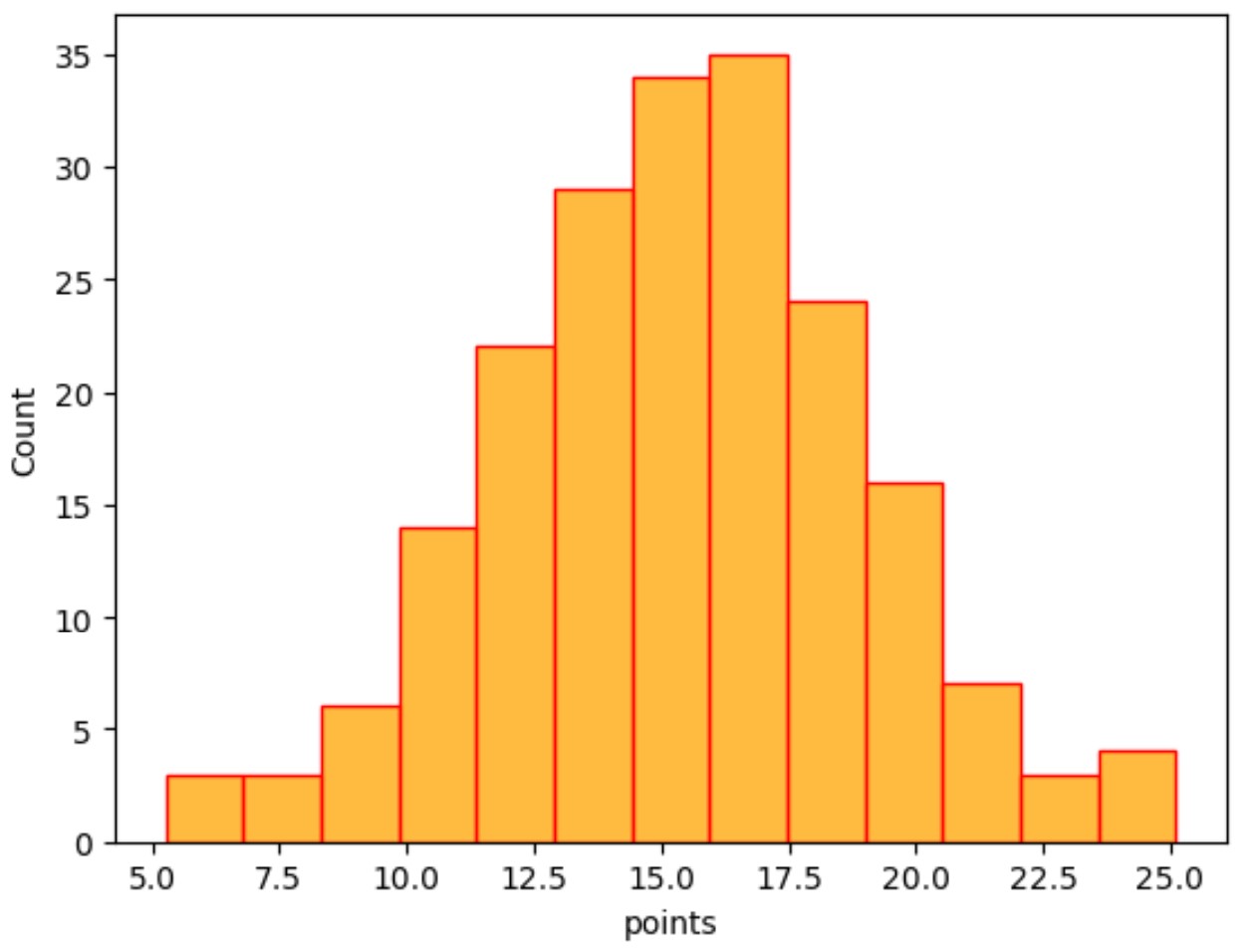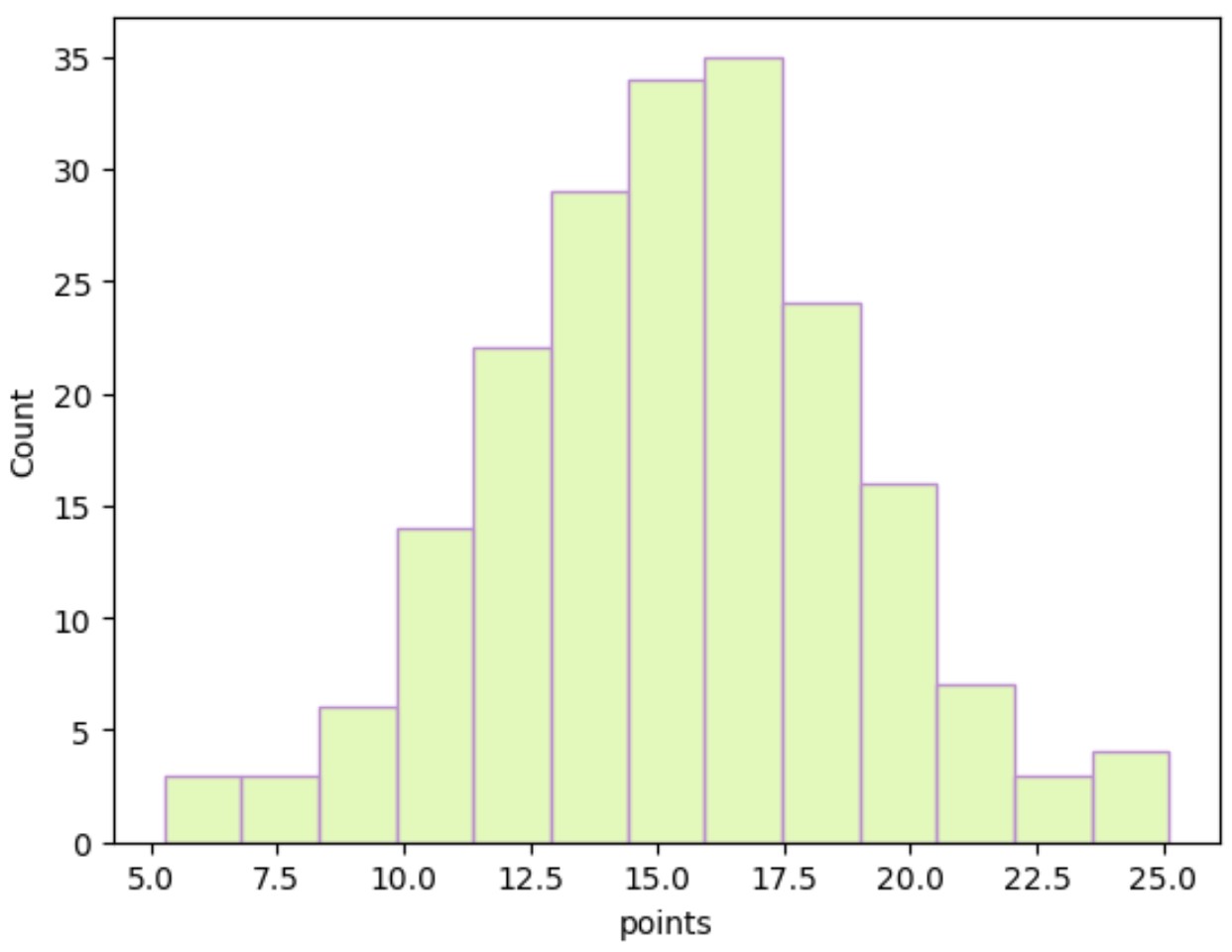วิธีการเปลี่ยนสีของฮิสโตแกรมของ seaborn
คุณสามารถใช้อาร์กิวเมนต์ สี และ สีขอบ ในทะเลเพื่อเปลี่ยนสีเติมและสีขอบของแท่งในฮิสโตแกรมตามลำดับ:
sns. histplot (data=df, x=' some_variable ', color=' orange ', edgecolor=' red ')
ตัวอย่างต่อไปนี้แสดงวิธีการใช้ข้อโต้แย้งเหล่านี้ในทางปฏิบัติ
ตัวอย่าง: เปลี่ยนสีฮิสโตแกรมของสัตว์ทะเล
สมมติว่าเรามี DataFrame แพนด้าต่อไปนี้ซึ่งมีข้อมูลเกี่ยวกับคะแนนที่ทำโดยผู้เล่นบาสเก็ตบอล 200 คน:
import pandas as pd
import numpy as np
#make this example reproducible
n.p. random . seeds (1)
#createDataFrame
df = pd. DataFrame ({' team ': np. repeat (['A', 'B'], 100),
' points ': np. random . normal (size=200, loc=15, scale=4)})
#view head of DataFrame
print ( df.head ())
team points
0 A 21.497381
1 A 12.552974
2 A 12.887313
3 A 10.708126
4 A 18.461631
เราสามารถใช้โค้ดต่อไปนี้เพื่อสร้างฮิสโตแกรมใน Seaborn เพื่อให้เห็นภาพการกระจายของค่าในคอลัมน์ จุด :
import seaborn as sns #create histogram to visualize distribution of points sns. histplot (data=df, x=' points ')

ตามค่าเริ่มต้น Seaborn จะใช้สีน้ำเงินเป็นสีเติม และใช้สีดำเป็นสีเค้าร่างสำหรับแถบฮิสโตแกรม
อย่างไรก็ตาม เราสามารถปรับแต่งสีเหล่านี้ได้โดยใช้อาร์กิวเมนต์ สี และ สีขอบ :
import seaborn as sns #create histogram to visualize distribution of points sns. histplot (data=df, x=' points ', color=' orange ', edgecolor=' red ')

โปรดสังเกตว่าขณะนี้ฮิสโตแกรมมีสีเติม สีส้ม และสีเส้นขอบ สีแดง
โปรดทราบว่าคุณสามารถใช้รหัสสีฐานสิบหกเพื่อปรับแต่งเพิ่มเติมได้:
import seaborn as sns #create histogram to visualize distribution of points sns. histplot (data=df, x=' points ', color=' #DAF7A6 ', edgecolor=' #BB8FCE ')

หมายเหตุ : คุณสามารถค้นหาเอกสารฉบับเต็มสำหรับฟังก์ชัน seaborn histplot()ได้ ที่นี่
แหล่งข้อมูลเพิ่มเติม
บทช่วยสอนต่อไปนี้จะอธิบายวิธีการทำหน้าที่ทั่วไปอื่นๆ ในทะเล:
วิธีการตั้งค่าสีของแท่งใน barplot ของ Seaborn
วิธีสร้าง barplot ที่จัดกลุ่มใน Seaborn
วิธีการสร้างแปลง Seaborn หลายแปลงในรูปเดียว